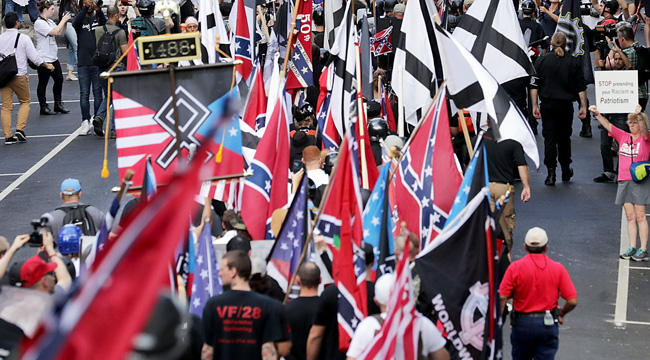
In 2017, Nazis are still very much bafflingly present in America, even bringing deadly summer violence to Charlottesville. Proud Nazi Richard Spencer still manages to spread his message while displaying scant intelligence, and white supremacists have also managed to drag pizza into their platform. For whatever reason, the New York Times decided to wade into the debate in a very unsavory way — with a profile called “A Voice of Hate in America’s Heartland” that paints a sympathetic portrait of a white supremacist who loves to shop at Target and eat at Panera in suburban Ohio.
Not to mention that the writer, Richard Fausset, interviewed his subject at an Applebee’s. He literally describes Tony Hovater as “the Nazi sympathizer next door” who thinks that Adolf Hitler truly “believed he was fighting for his people and doing what he thought was right.” Further, Hovater is referred to as “polite and low-key” — words that echo President Trump’s argument (at a bonkers press conference) that the tiki-torch wielding white supremacists and Nazis at Charlottesville included some “very fine people.” Yes, the NY Times sort-of did a “both sides” piece that had the effect of humanizing a Nazi.
The feature immediately led to The Atlantic publishing a scathing parody, and needless to say, Twitter wasn’t thrilled about being told that Nazis are ordinary people, just like you and I!
https://twitter.com/sadydoyle/status/934558246861406208
https://twitter.com/SaraJBenincasa/status/934583978178179072
Hey @nytimes, look! Nazis can seem like regular folks! From the @AuschwitzMuseum: a photo of Nazi staffers having fun between killing Jews: pic.twitter.com/M0a38bA6SU
— Soledad O'Brien (@soledadobrien) November 26, 2017
https://twitter.com/kumailn/status/934596826694434817
https://twitter.com/Oniropolis/status/934757900232396800
https://twitter.com/Felonious_munk/status/934792080718745600
People: Hi, I'd like to live as part of a civil society
Nazis: Nope. I think you and everyone like you should be slaughtered. I gleefully embrace murder and terrorism.
People: ….
New York Times: His favorite food at Panera is the Frontega Chicken Panini
— Kevin Gannon (@TheTattooedProf) November 26, 2017
.@RichardFausset is the one who wrote that love letter about the Nazis for the @nytimes
Look for his follow-ups:
KKK Grand Wizard is just like Santa Claus
What To Get Child Molesters for Christmas
KKK Hanukah Songs
Women Politicians Or Satan’s Spawn: You Decide
— Trump owes $$$$$$$$$ (@jonathanjewel) November 26, 2017
Nazis: "We want to kill all minorities!"
White journalists at the New York Times: "Ok, but please tell us more about your favorite food and show."
— Deniz S. (@MrFilmkritik) November 25, 2017
I wonder why Holocaust museums don't have a display dedicated to the polite and courteous Nazis.
No, wait, I don't wonder that.
And I don't know why the New York Times thinks I should.
— Bilal Dardai (@bilald) November 26, 2017
Tip of the day: Nazis are horrible people who do NOT need to be humanized. Please don't do it. Looking at you, New York Times.
— DannyKorcz@kolektiva.social🏴✡️ (@dannykorcz) November 26, 2017
Amid the fallout over Fausset’s piece, people began to notice that the NY Times ran an “Insider” take as well. Within that followup, Fausset acknowledges that there was a “hole at the heart” of his piece, and he says that he could “feel the failure” upon filing an early version and attempting to follow up with Hovater on the phone. That is to say, the piece never answered this question: “[What] explained Mr. Hovater’s radical turn?” Instead of killing the piece, the NY Times ran with it, so the feature effectively functioned as a puff piece for the contemporary Nazi movement in America.
the nyt reporter who profiled the ohio nazi basically confesses he didn't get much. and that the intvws didn't connect any dots for him. sometimes you gotta know when to kill a story. https://t.co/1VyuN0hNal pic.twitter.com/dRbte68N01
— Charlie Warzel (@cwarzel) November 25, 2017
However, not everyone was upset. Michael Ian Black pointed out on Twitter that perhaps it’s a good thing to illustrate that Nazis are “nothing.”
https://twitter.com/michaelianblack/status/934517316213264389
UPDATE: Following the furor, NY Times National Editor Marc Lacey has issued a response, which reads in part:
We regret the degree to which the piece offended so many readers. We recognize that people can disagree on how best to tell a disagreeable story. What we think is indisputable, though, is the need to shed more light, not less, on the most extreme corners of American life and the people who inhabit them. That’s what the story, however imperfectly, tried to do.
(Via New York Times)
